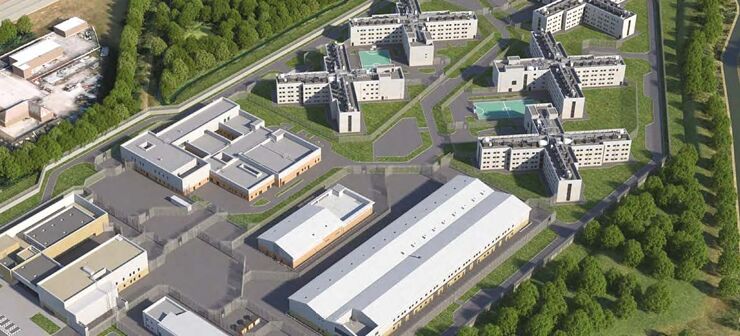
How the Ministry of Justice is using NEC Contracts under a Framework Alliance Contract to deliver its new prisons programme.
The Ministry of Justice (MoJ) has embarked on an extensive programme of works to deliver 20,000 much needed prison places across the country. This represents the biggest prison building programme in more than a century. To achieve this, the MoJ created the Alliance 4 New Prisons (A4NP), which appointed four Tier One contractors, who would each deliver one of the four new prisons.
The first of the new prisons, HMP Millsike, has recently reached practical completion. We caught up with Melissa Dudley, Commercial Construction Director, and Caron Johnson, Sustainable Construction Project Lead at the MoJ about the project, the benefits of a collaborative approach, the successes to date and advice for other organisations on the same journey.
Can you tell us a bit about the HMP Millsike project?
MD: HMP Millsike near York is a category C prison, which is designed for those approaching the end of their sentences, with a focus on rehabilitation using the latest research on prison design. It consists of six house blocks – with space for around 1500 prisoners – as well as ancillary buildings that house the heavy and light industry workshops and healthcare and education facilities. It entered main works delivery in July 2022 with Kier as the main contractor, and is worth around £400 million.
CJ: It is also groundbreaking from a sustainability perspective and goes beyond what previous prison projects achieved. It is the first all-electric prison and the first to specify a biodiversity net gain (BNG) target of 10%. From the beginning we set ambitious targets for environmental performance using the BREEAM framework and we embedded environmental requirements in the project using the ISO 19650 standard for information management.
Can you explain the contract model on this project?
MD: We used the Crown Commercial Services’ Construction Works and Associated Services Framework for procurement on the new prisons programme, and through that we adopted an Alliance approach. The Alliance 4 New Prisons utilises an integrated client team model with professional services providers and consisted of four main contractors.
The scale and complexity of the project, as well as the need for standardisation of the prison design across the four new sites, meant we needed to create a contract model that would allow collaboration and engagement between the members of the Alliance. We used a Framework Alliance Contract (FAC-1) as our umbrella collaboration agreement. This covers the whole programme up to its projected completion in 2031 and ensures everyone has common goals with clear phases of work.
We then used the NEC4 Professional Services Contract (PSC) and NEC4 Engineering and Construction Contracts, both standard and short-contract, to govern the work phases of each project. This means each instruction for work is not a new contract as everyone has signed up to the Alliance agreement, but having separate NEC contracts for each site avoids the complexities that would come with having a single contract, such as joint liability between the main contractors.
How has the type of contracts used and the Alliance approach helped achieve the project and programme objectives?
MD: During the initial stages of the Alliance, the FAC-1 itself provided the vehicle for early engagement and open information sharing in a structured way that enabled innovation, creativity and flexibility. This was continued through the NEC contracts. This approach not only gave us a clear mechanism for instruction of works and robust management using tried and trusted industry contract terms but also drove knowledge sharing, earlier engagement with the supply chain, innovation and design efficiencies. This more collaborative type of agreement encouraged all the parties to think and work differently, and to move away from those traditional adversarial construction relationships. The NEC contracts also provided clear mechanisms to deal with the inevitable changes and risks that materialise during projects of this size and complexity.
CJ: The collaborative approach with the contracts was key to achieving our environmental objectives. While we didn’t use sustainability focused clauses such as X-29, we baked our sustainability aims and requirements into the design, the KPIs and specified key scope areas such as the achievement of mandatory BREEAM credits. When we first looked at setting these targets in the contract, the Alliance flagged the issue that there were not products on the market that could deliver in areas such as water usage while still meeting the strict requirements for prison environments. We worked closely with the Alliance to agree a stretch target BREEAM score of 85, which would mean a BREEAM Outstanding rating, from a baseline of 70. In effect we’ve been able to improve the sustainability of the project by taking a less prescriptive, more collaborative approach to how we push the boundaries in a way that appreciates the risk and complexity for the parties.
MD: : I think that’s a really important part of this. From a client perspective we are not just setting requirements and saying deliver them, we are working with our delivery partners to make sure everyone understands the aims and objectives and we’re looking at how we can overcome barriers together.
Can you give some examples of how the collaboration has worked in practice?
MD: Given the long-term nature of the project we wanted to ensure that the knowledge gained on one project could be retained and shared across all the projects and partners. To help achieve this we set up a Lessons Learned portal to provide a way for all members of the Alliance to share knowledge on a range of different areas including sequencing of works, working with the MoJ, the approach to building these specific designs and how to work better on these sites. With all this knowledge in one place we are in a better position to share those lessons going forward.
CJ: The Special Interest Groups have been another important part of the process. These are groups created within the overall Alliance that include all parties that have a focus on particular aspects of the project. It provides a way to ensure that everyone is working towards the same goal and it allows us to work together to solve any issues as early as possible in the process. This includes client functions, professional services, main contractors and supply chain. It really has reduced costs and risks on the project.
What advice would you give to other organisations who are looking to adopt NEC contracts in a similar way?
MD: If you are new to NEC, it is worth taking some time from the outset to explore what can be done within these contractual arrangements. It's really important to think about what you want to achieve and what the objectives are and then look at how the mechanisms and processes within the NEC Contracts can help deliver it. Also, in terms of implementation, NEC has some excellent training options to ensure that the teams that are administering the contracts are fully prepared to do so.
We've been on a positive learning journey at the MoJ and while there are still improvements that we could make, I would absolutely use this approach again on future programmes.
To gain further insight watch the full MoJ webinar below:




